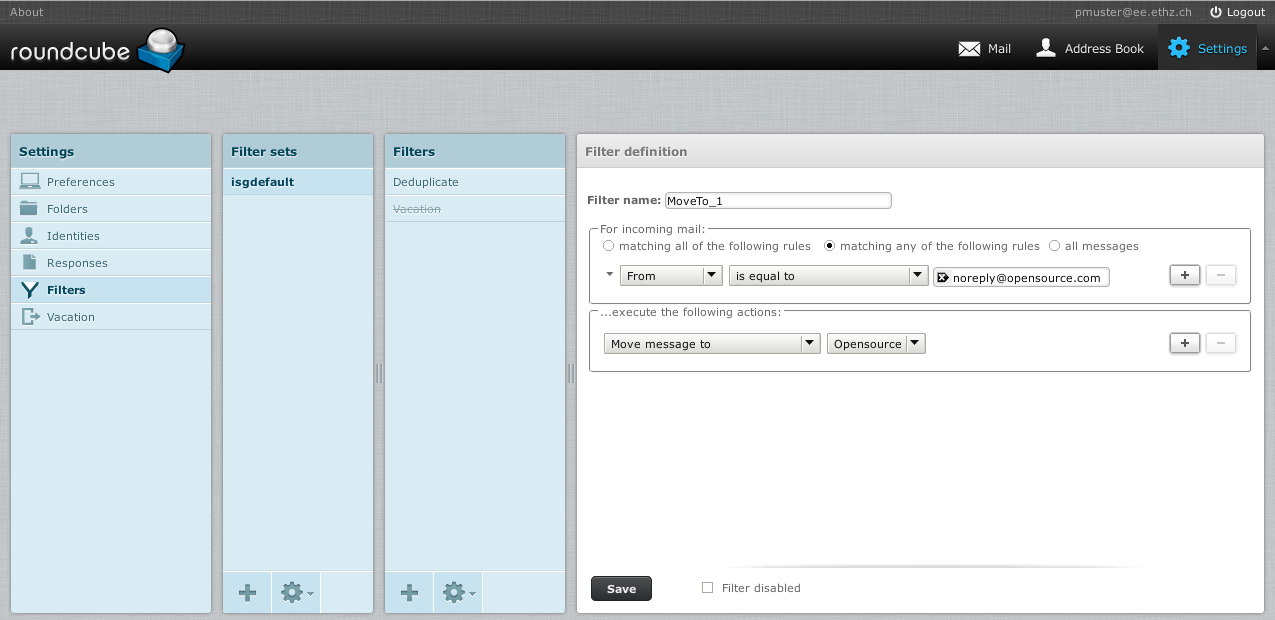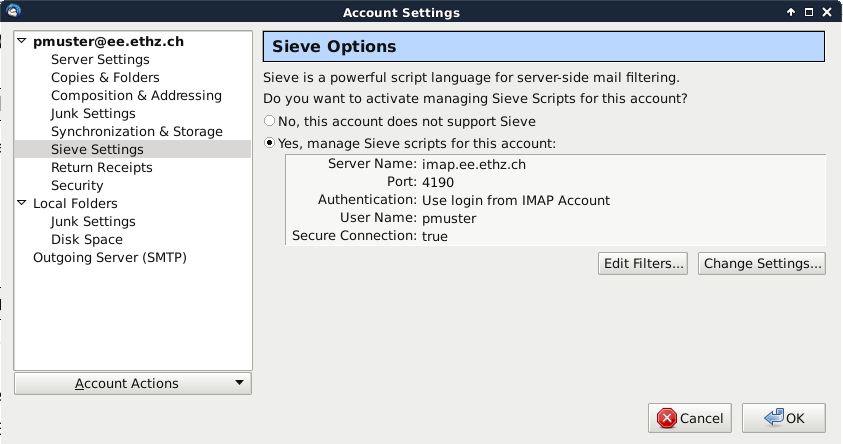|
Size: 9526
Comment:
|
Size: 9467
Comment:
|
| Deletions are marked like this. | Additions are marked like this. |
| Line 88: | Line 88: |
| 1. Enable Sieve filtering by right-clicking on you D-ITET mailfolder and choosing '''Settings''' (see screenshot below). | 1. Enable Sieve filtering by right-clicking on you D-ITET mailfolder and choosing '''Settings -> Sieve Settings''' (see screenshot below). <<BR>> {{attachment:thunder1.png}} <<BR>> |
| Line 104: | Line 107: |
| 1. In the options menu, select '''Message Filters → Sieve Message Filters...''' | 1. In the '''Tools''' pull-down menu, select '''Sieve Message Filters...''' |
| Line 106: | Line 109: |
| There is another interface to edit Sieve filters, available in the Options menu through ''Message Filters → Message Filters → Server side filters''. But we recommend the ''Sieve Message Filters'' mentioned before. | |
| Line 108: | Line 110: |
| 1. The interface is self-explanatory. Once you start to create a new Sieve filter, the right hand side shows help for available Sieve commands. But you will have to write your filters all by yourself without the help of dropdown lists as in the Roundcube webmailer. | 1. The interface is self-explanatory. You see your default and activated filter script '''isgdefault''' in the list of the "Serverside Sieve mailfilters". Click the button '''Edit''' to edit the default file '''isgdefault''' or create a new one and activate it after editing. No rule creation wizzard is available so the offered syntax check function is very helpfull. |
Email filtering
Email filtering can be done through Sieve. With Sieve, the filter rules are stored and applied on the mailserver. This is an advantage over client-side filtering, where emails are only filtered if you read them with a specific email client.
You have several options to manage your filters. You can use
Our roundcube webmailer https://email.ee.ethz.ch/
- Mozilla Thunderbird with the Sieve plugin
- KDE desktop program "Sieve Editor" (is installed on all managed linux clients)
We recommend to use our webmailer in the first place. Especially vacation messages can be defined in a very comfortable way through the webmailer. See Email/Vacation for further details. However, the Sieve interface of the webmailer only allows to define rather simple filter rules. For advanced rules, you have to use the Thunderbird plugin or the command line tool.
![]() Do not switch back to the webmailer sieve management plugin after you have modified your filter file with another tool. The plugin uses own markers inside the sieve configuration file and does not recognize all available sieve filters. If you switch back to the webmailer the results of modifications are unpredictable.
Do not switch back to the webmailer sieve management plugin after you have modified your filter file with another tool. The plugin uses own markers inside the sieve configuration file and does not recognize all available sieve filters. If you switch back to the webmailer the results of modifications are unpredictable.
The following sections will explain how you get started to manage your email filters with these tools. Choose the one that fits you best.
Manage email filtering rules with the webmailer
Login on https://email.ee.ethz.ch/.
Choose Settings → Filters.
In the Filter sets list, you will see the entry isgdefault. You may create other filter sets, but please note that only one filter set can be active at a time. We thus recommend that you select and use the isgdefault filter set through the webmailer.
In the Filters you can see the two default filters already configured in the isgdefault filter set:
Deduplicate (enabled) : discards duplicates of an already received mail
Vacation (disabled) : vacation message template
In the Filters column you may now create new filters with the + Symbol at the bottom of the column. Or you can select existing filters and adapt them or enable/disable/delete them through the sprockets symbol. The filter form is self explanatory. You can create or change your filters with drop-down lists and text fields. To edit the Vacation filter it is best to do that through Settings → Vacation.

In the first section For incoming mail you define which emails are affected by this rule. With the + Symbol on the right you can add additional conditions. And on the top you define how these conditions are concatenated:
Option |
Description |
Match all of the following rules |
All conditions have to be fulfilled before the action below is applied |
Match any of the following rules |
At least one condition has to be fulfilled before the action below is applied |
All messages |
The action is applied to any email you receive |
Here are some more detailed explanations of expressions you might come across when defining new filter rules:
Comparator |
Description |
default |
case insensitive comparison |
strict (octet) |
case sensitive comparison |
case insensitive (ascii-casemap) |
case insensitive comparison |
numeric (ascii-numeric) |
comparison of numbers |
The header field specifies, against which header field the comparison should be applied. This allows you to e.g. compare a "Received" field for its date.
If there are multiple header fields of the type you specified, you can select the one that should be used with the index value.
Modifier |
Description |
none |
Test against all header fields |
address |
Test against all header fields that contain addresses, i.e. From, To, Cc, Bcc, Sender, Resent-From, Resent-To, ... |
envelope |
Test against email envelope (don't use this one unless you are familiar with email envelopes) |
If a address or envelope modifier is in effect, you may choose, against which part of the email address the comparison should be done:
Type |
Description |
all |
Compare against the whole email address user@domain.org |
domain |
Only compare against the domain part user@domain.org |
local part |
Only compare against the local part user@domain.org |
user |
Compare against the user part of the local part user+organisation@domain.org |
detail |
Compare against the detail part of the local part user+organisation@domain.org |
When one of your rules matches against the body of an email message, you can choose, how the email body should be transformed prior to the comparison:
Modifier |
Description |
text |
Compare against all text elemenst of an email body (i.e. plain text and html elements). Same as content type → text. |
undecoded (raw) |
Compare against the unmodified email body. Includes MIME part information. Don't use it unless you know what you are doing. |
content type |
Compare against all MIME parts of the message with the given content type. You would most often use content types like text, text/plain or text/html. |
After pressing the save-button in the picture above you have added a new filter Moveto_1 to the isgdefault filter set and the output screen of Settings → Filters now is:

Manage email filtering rules with Mozilla Thunderbird
Setup
First of all you need to install the Sieve plugin. Unfortunately, the version in the official Thunderbird plugin archive is too old (version 0.2.2). So you need to download the plugin directly from the Development Builds website. Choose the youngest release. At the moment of this writing this is sieve-0.2.3h.xpi. Once downloaded, you can install it in Thunderbird through Add-ons Manager → Install Add-on From File...
Enable Sieve filtering by right-clicking on you D-ITET mailfolder and choosing Settings -> Sieve Settings (see screenshot below).
Under the Sieve Settings menu entry, enable Sieve with Yes, manage Sieve scripts for this account and then select Change Settings...
Please make sure that you set at least the following options:In the Server tab:
Server Name → IMAP Server: imap.ee.ethz.ch
Server Port → 4190 (Default)
In the Security tab:
Connection Security → Force TLS
Authentication → IMAP Username and Password
Select OK to save the settings and to enable Sieve management from Thunderbird.
Edit Sieve Filters
In the Tools pull-down menu, select Sieve Message Filters...
The interface is self-explanatory. You see your default and activated filter script isgdefault in the list of the "Serverside Sieve mailfilters". Click the button Edit to edit the default file isgdefault or create a new one and activate it after editing. No rule creation wizzard is available so the offered syntax check function is very helpfull.
KDE desktop program "Sieve Editor"
Sieve filtering examples
Here is a Sieve tutorial to get you started: https://tty1.net/blog/2011/sieve-tutorial_en.html
Catchall filter
A catchall email domain somename.ethz.ch}} delivers emails to e.g. {{{team@somename.ethz.ch to the somename email account. It is the responsibility of that accounts owner to redirect that message to the right recipients (depending on the To address).
The following sieve settings in the somename email account will redirect messages to "team@somename.ethz.ch" to the users "user1", "user2", and "user3."
if address :is ["to", "cc", "bcc"] "team@somename.ethz.ch" {
redirect "user1@ee.ethz.ch";
redirect "user2@ee.ethz.ch";
redirect "user3@ee.ethz.ch";
}
Deduplicate filter
With procmail it was possible to delete duplicate emails (i.e. if you get exactly the same email through different ways) with the following rule in .procmailrc:
:0 Wh: $HOME/.procmail_msgid_lock | formail -D 8192 $HOME/.procmail_msgid_cache
With Sieve you can get the same result with the following rule:
require ["duplicate"];
if duplicate {
discard;
}
Header manipulations
Email headers can be edited through the editheader plugin. The following example replaces the subject for emails sent to team@somename.ethz.ch with [TEAMINFO] Original subject.
require ["editheader", "variables"];
if address :is ["to", "bcc", "cc"] "team@somename.ethz.ch" {
if header :matches "Subject" "*" {
set "subject" "${1}";
deleteheader :index 1 "Subject";
addheader :last "Subject" "[TEAMINFO] ${subject}";
}
}
